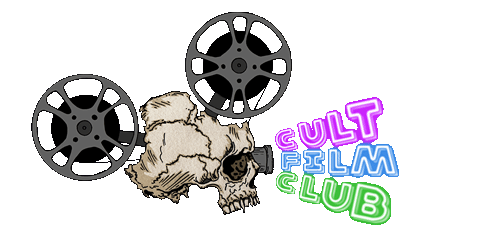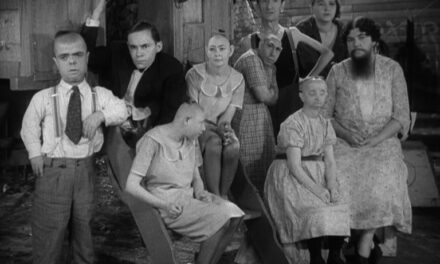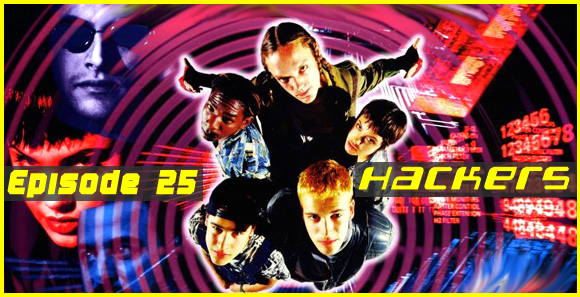During the conversation on this month’s episode of the Cult Film Club, we spent some time discussing the visual style of the vampires portrayed in From Dusk Till Dawn. We were trying to figure out when the trend of the more monstrous design, being fully “Vamped-Out”, started and what flicks influenced the look of the vampires that inhabited the Titty Twister. We threw out flicks like The Lost Boys, Bram Stoker’s Dracula, and Buffy the Vampire Slayer (the show and the movie) as productions that broached this first, but it turns out we were both a bit right and very ignorant of the fugly vampires of cinema. So I thought it would be an interesting exercise to track down as many grotesque vampires as I could find and try to get a better feel for this sub-genre of vampiric design.
Traditionally, vampires in film have been highly romanticized playing on the sexuality of the attraction, hunting, and obsession aspects of the genre. Generally handsome leading men have been cast in the roles of characters like Dracula, Vlad Tepes, Lestat, or the dozens of Counts or Princes of Darkness, but there are also a lot of beautiful ladies that have taken on the roles of Camilla, Countess Bathory, or other Princesses of Darkness. Of the hundred or so films I dug into, 90% of the time the creature was depicted as human, maybe pale or ashen skinned, typically had long, symmetrical fangs, and might have had uniquely colored eyes (usually yellow or red.)

The vampires I was looking for on the other hand were truly creatures of darkness. Take the Mexican vampires in Tarantino and Rodriguez’s From Dusk Till Dawn. Though like in most vampire mythos the characters are depicted as very normal humans at first, when these characters vamp-out they take on insanely serpentine or grotesque features. One of the most famous is the character played by Salma Hayek, Santanico Pandemonium, the potential head vampire and dancer at the Titty Twister. Her make-up was extremely serpentine, so much so that she was missing all of her teeth between her canines which was a very unique look. As a side note, visually, one of the most often seen design choices in vampire effects makeup and prosthetics is the placement of fangs in the mouth. A, are there even fangs? B, if so, what teeth are typically used? The canine teeth are the most obvious and most used teeth, but as we’ll see below there can be all over the place (or even all of the teeth!)
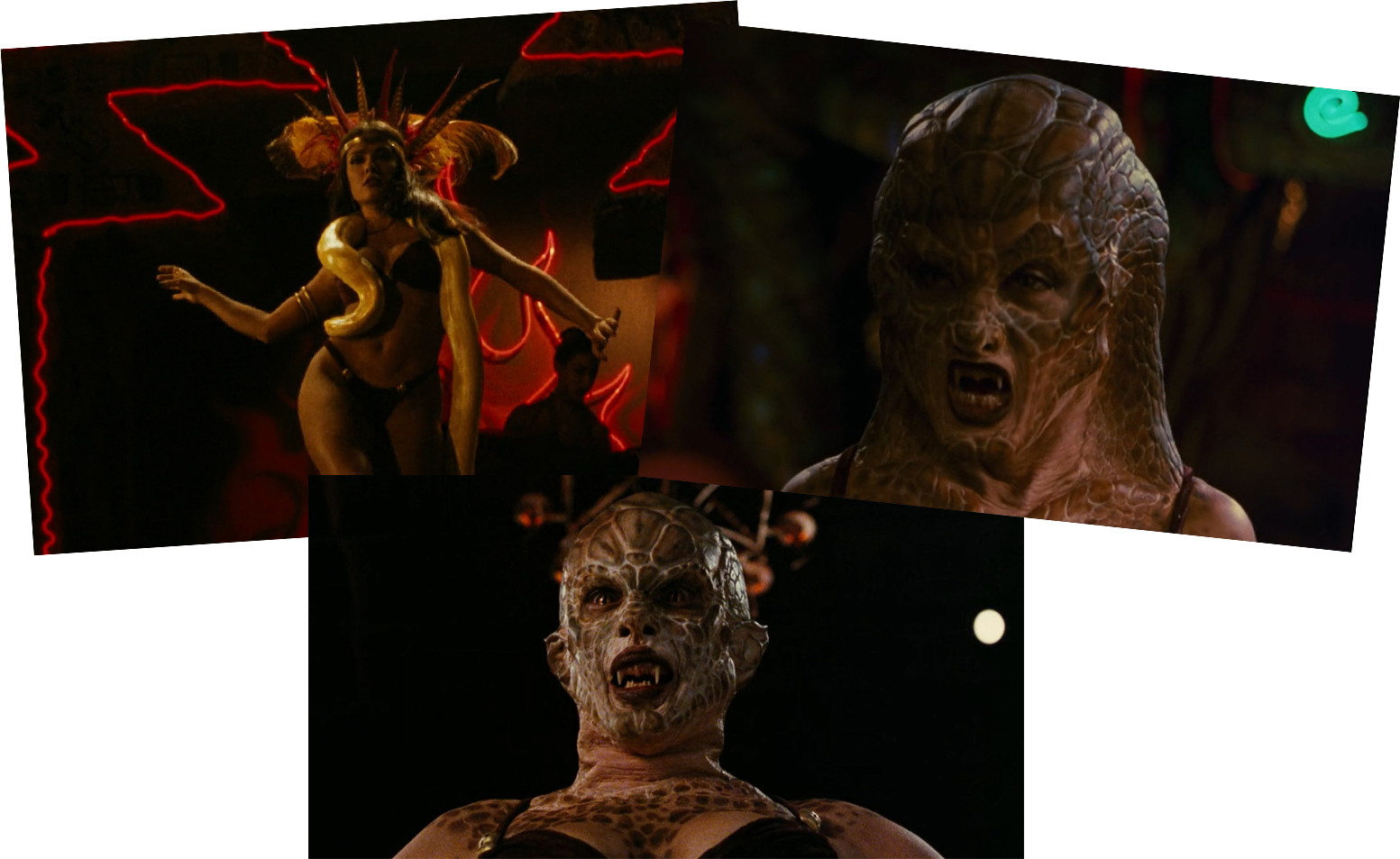
Since From Dusk Till Dawn spawned this conversation, I thought I should highlight the various manifestations of vampire makeup seen in the film. Up top we have a group of seriously fugly naked vampires that take a lot of influence from wolves, bats, and snakes. These would either be the ultimate or most generic depending on your point of view. But not all of the vampires took this form. Quentin Tarantio, who plays psychopath Richie Gecko in the film, has a much different look to his vamp-out. Taking a cue from his naturally high forehead and distinct chin, KNB effects went with a design that highlighted these features giving him a “large noggin” vamp-out. His final form reminds me more of Viggo the Carpathian from Ghostbusters II than a vampire per-se, but it was very effective on screen to say the least.
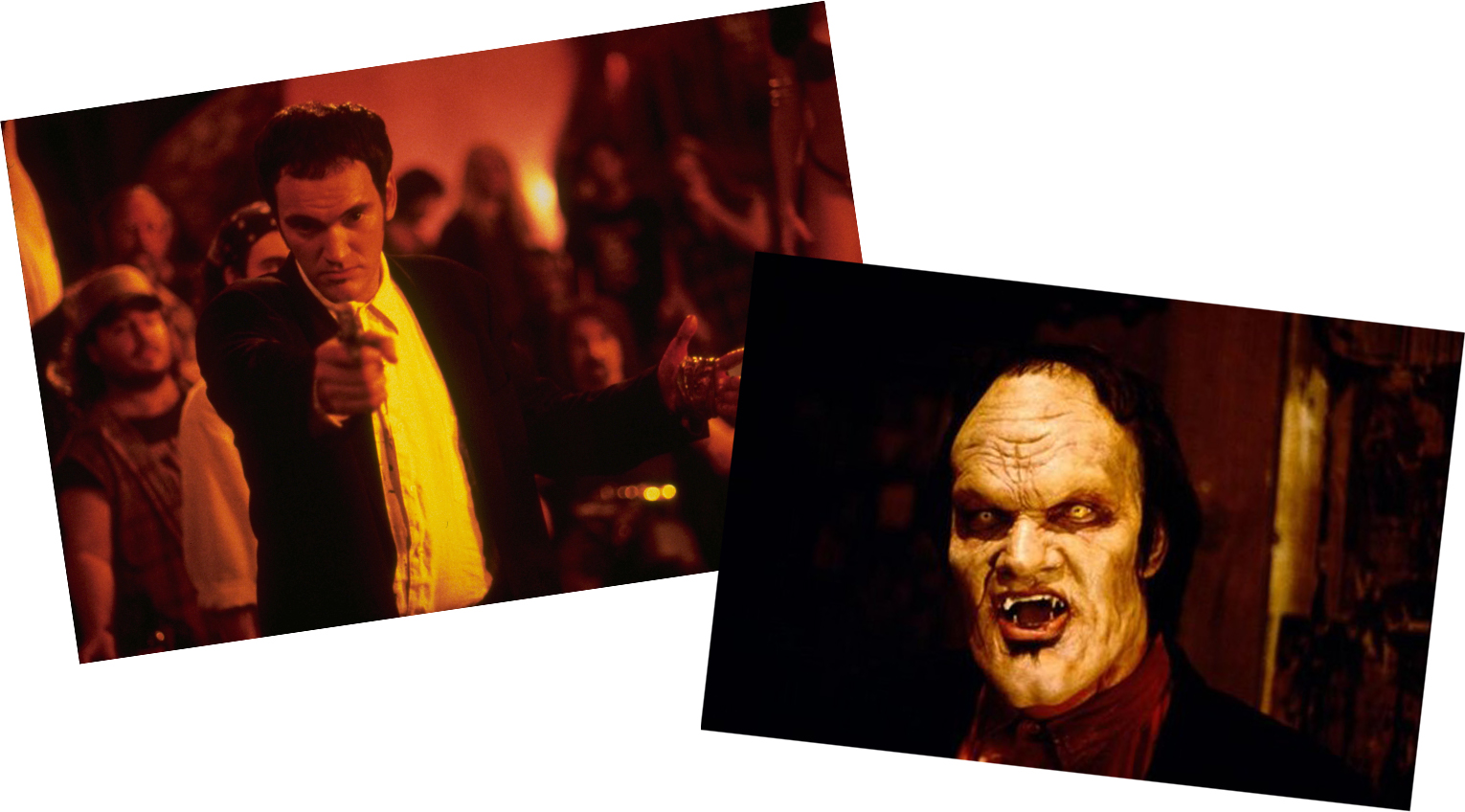
The majority of the other “face” characters, ones that were portrayed by more famous actors like Cheech Marin, Harvey Keitel, Fred Williamson, Danny Trejo or Tom Savini all have a more stylistic look to their vamp-outs. Heavy brows, shortened, yet pointy ears, and a lot of interesting wrinkle detail around the cheeks, mouths and noses. In fact, one of the oddest attributes to the From Dusk Till Dawn vampires are they noses. Again, not to continuously call back to other non-vampire films, but this level of detail reminds me a lot of the make-up effects used on certain characters in Clive Barker’s Nightbreed. Some of these characters, like Williamson’s Frost, even has a weird symmetry to his face that makes it look like it might split open like the Predator at any moment.
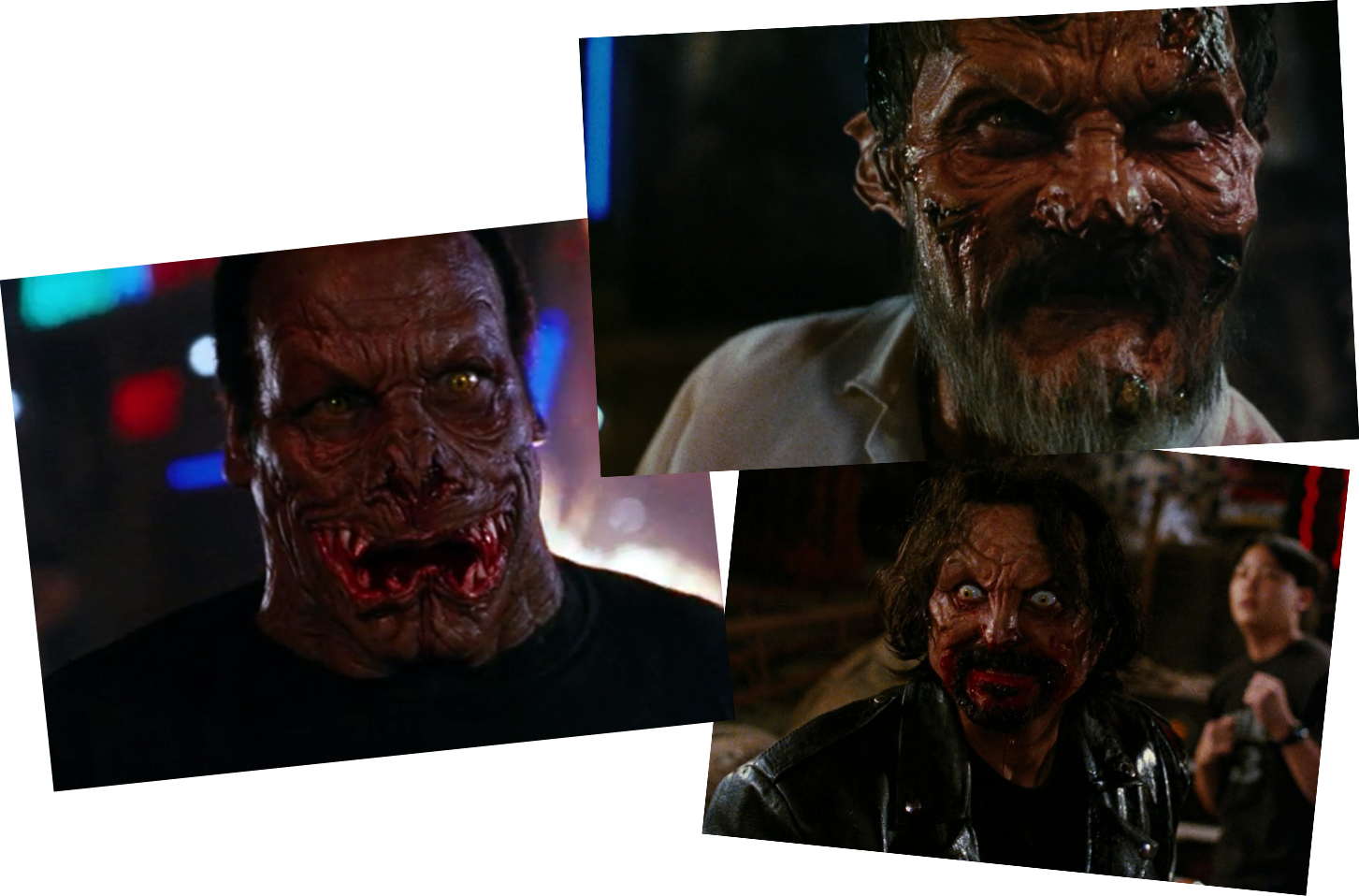
So let’s look back at some more notable monstrous vampires from cinema past. A very obvious place to start would be Max Schreck as the Count Orlock in Nosferatu from 1922. This silent film, not authorized by the Stoker estate to adapt the story of Dracula almost didn’t survive an infringement court battle that ordered all prints of the film destroyed. Luckily copies of the film did survive and almost a century later we can still enjoy this creepy, atmospheric film. Schreck’s vampire isn’t a shape-shifter, and always sports a gnarly, rat-like visage (designed by Albin Grau) in the film. This was one of, if not the first vampires on film to sport fangs, I believe, as well as the first to invoke sunlight as a means by which vampires can be destroyed.

Speaking of films that almost didn’t make it, how about a film that is still lost to time? 1927’s London After Midnight starring Lon Chaney in a dual role of Prof. Edward C. Burke and the ghastly “Man in the beaver hat”, who may or may not be a vampire (much of the surviving imagery sure points to the ghoul being one.) The film, directed by Todd Browning (who would go on to direct Dracula for Universal), saw its last surviving copy destroyed in an MGM vault fire, and all that remains beyond still photos are very rare copies of the novelization and a 2002 reconstructed version that uses still and title cards to tell the story. Chaney was famous for doing his own makeup work and employed some of the techniques he utilized on his Phantom of the Opera role including wire rings set into the makeup to make his eyes stay open and bulge. If the Man in the Beaver Hat is indeed a vampire, this might be a first where all the teeth are fangs.
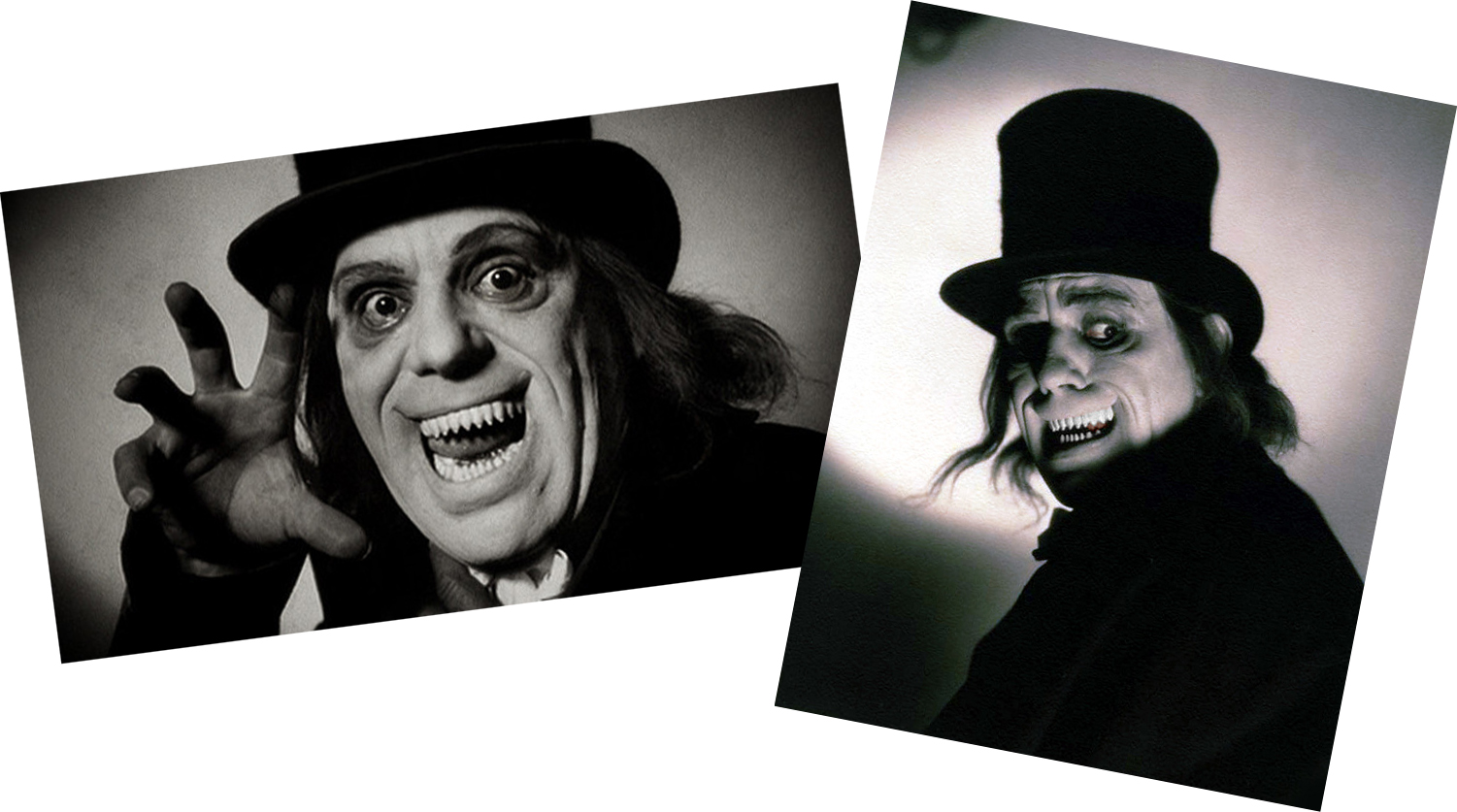
As far as the fugly vampire goes, from what I can tell it was sort of retired from film for a number of years. While there were tons of vampire films being produced, we wouldn’t see another truly ghastly vampire until the Italian production of The Vampire and the Ballerina in 1960. This film is notable for not only bringing back the long dormant ugly vampire, but also of mixing aspects of sex and horror on screen in Italian film. I’m not sure who is under that vampire mask, and these are masks in this film, but I do know that it was created by Cesare Gambarelli and designed by Amedeo Mellone.

Staying in Italy for a bit, and playing around with the general definition of what a vampire is and is not, we have Atom Age Vampire (aka Seddok) also from 1960. The main antagonist and “vampire”, Dr. Levin (played by Alberto Lupo), is a self mutilated scientist that has created a serum that can sustain the life and beauty of his love that was disfigured in a car crash. Levin used a formula amplified by radiation to make himself look like a monster so that it will be easier to hunt for young victims that he needs in order to drain their essence so he can use it to save his love. He does this by piercing their neck with a syringe to extract the material he needs for his serum. So not a technical vampire in the strictest sense, but there are a lot of vampiric qualities to his character (like George Romero’s Martin.) The makeup was designed by Euclide Santoli.
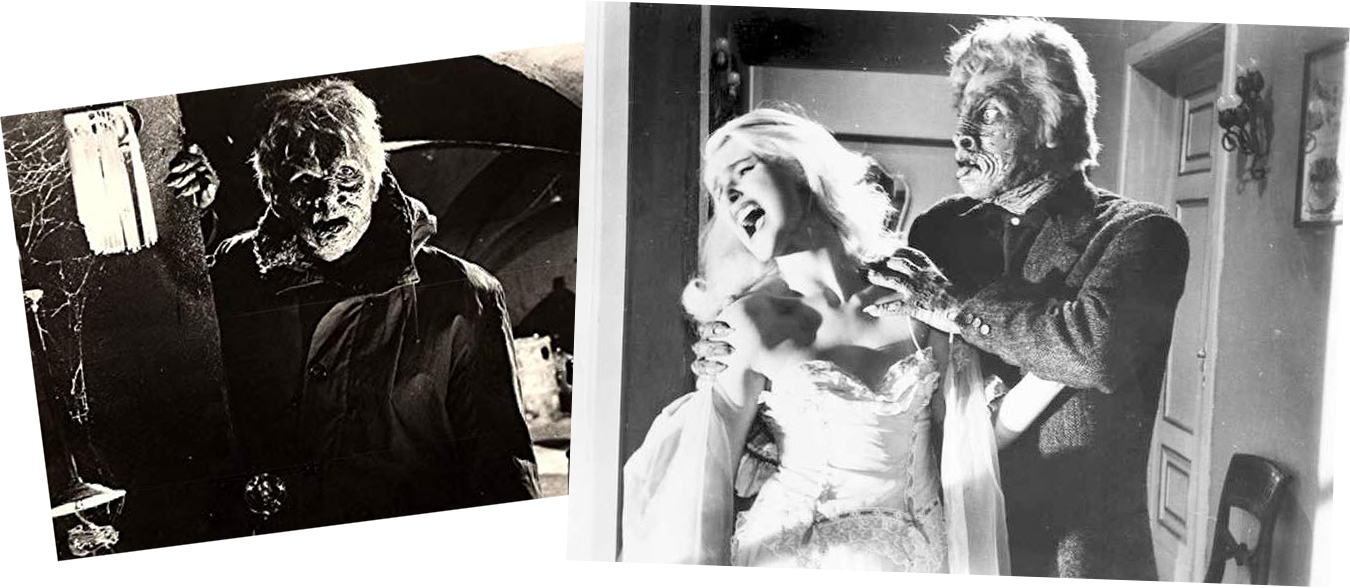
Though I’m sure I’ve overlooked some, the next really gnarly vampire I could find is Werner Herzog’s remake of the 1922 Nosferatu called Nosferatu the Vampyre from Germany in 1979. This version of the story keeps the overall design of Schreck’s Orlock, but the production was able to utilize the name Dracula as the original novel went into the Public Domain in 1962, side-stepping the legal hurdles of the original film. In this version, Klaus Kinski portrays Dracula, with a slightly more naturalistic take on Albin Grau’s design, this time designed by Reiko Kruk. They kept the rat-like middle teeth fangs and the overall bald, pallid long fingernail appearance.

In that same year, over in the United States, the first adaptation of Stephen King’s Salem’s Lot was released as a television mini-series starring Reggie Nalder as Mr. Kurt Barlow. Barlow, though more of a classically romanticized vampire in King’s novel, is instead envisioned as more of a creature in the mini-series. This was apparently at the behest of Producer Richard Kobritz, who felt that the character would be more effective as the embodiment of evil, and thus steered the design of the character to a Nosferatu-like look. Though not accurate, this was one of the things I always loved about this series as Barlow scared the crap out of me as a kid in a much more visceral way than he did in the book (which I also read while fairly young.) Barlow’s make-up was done by Jack H. Young.
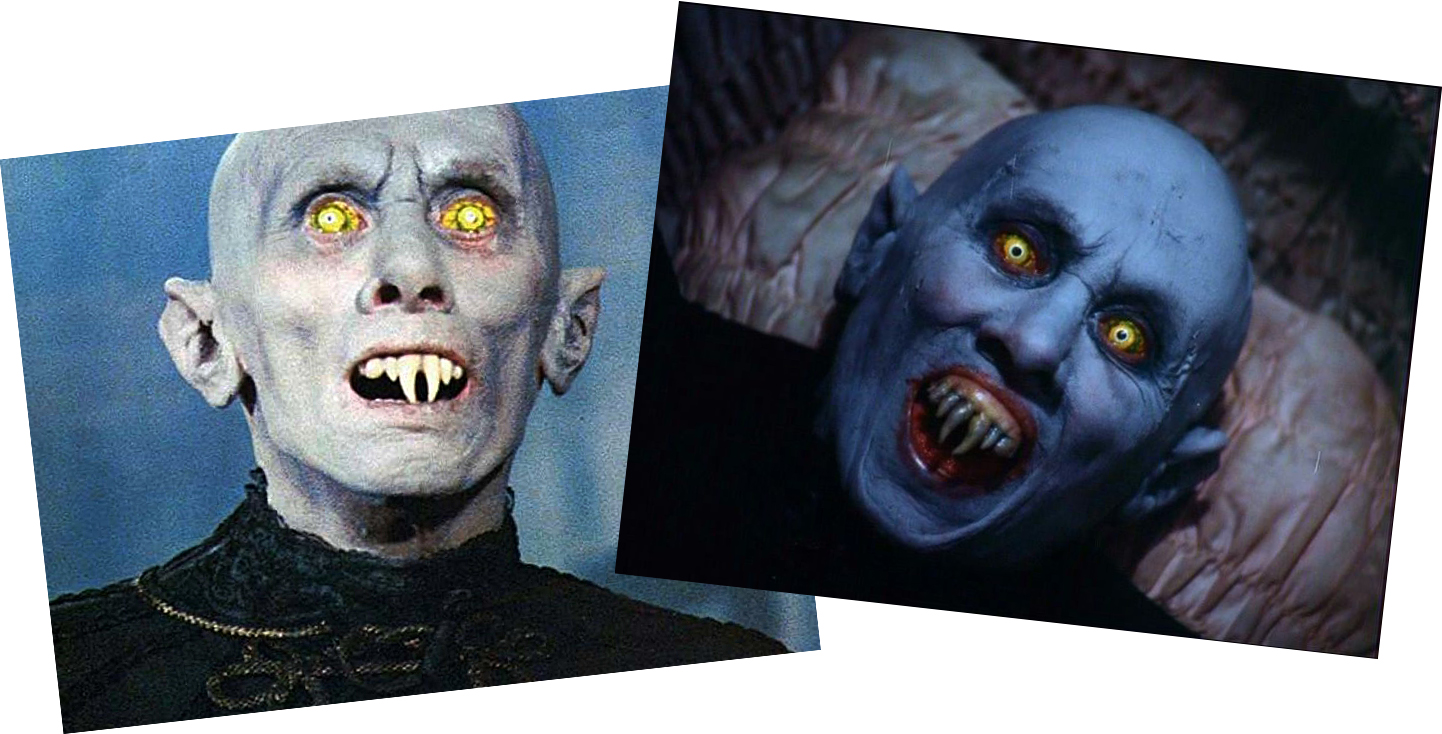
At this point in the timeline we’re both entering into a very fruitful time for both vampire films and creature make-up effects work. The next super gnarly vampires we’d see on film were in the Tom Holland flick, Fright Night from 1985. Chris Sarandon’s awesome portrayal of vampire neighbor Jerry Dandridge straddled a lot of fences. On the one hand he was great at playing the debonair, handsome version of the character, but also got a chance to sink his teeth into a way more ghastly version towards the end of the film. The vampires in Holland’s film are all over the place in terms of the spectrum between beautiful and gnarly, and it’s because of this that I feel that this movie in particular had a very large impact on the design work for From Dusk Till Dawn. I mean just look at how insane the fey Amanda Bearce as Amy Peterson becomes when she literally has a garbage disposal as a mouth! I also love that this film distances itself a bit from most vampire movies by giving the vampires six fangs, fur on top (both the eye and canine teeth) and two on bottom (the lower canines.) The creature make-up effects work for the film was created and designed by Randall William Cook of Entertainment Effects Group.

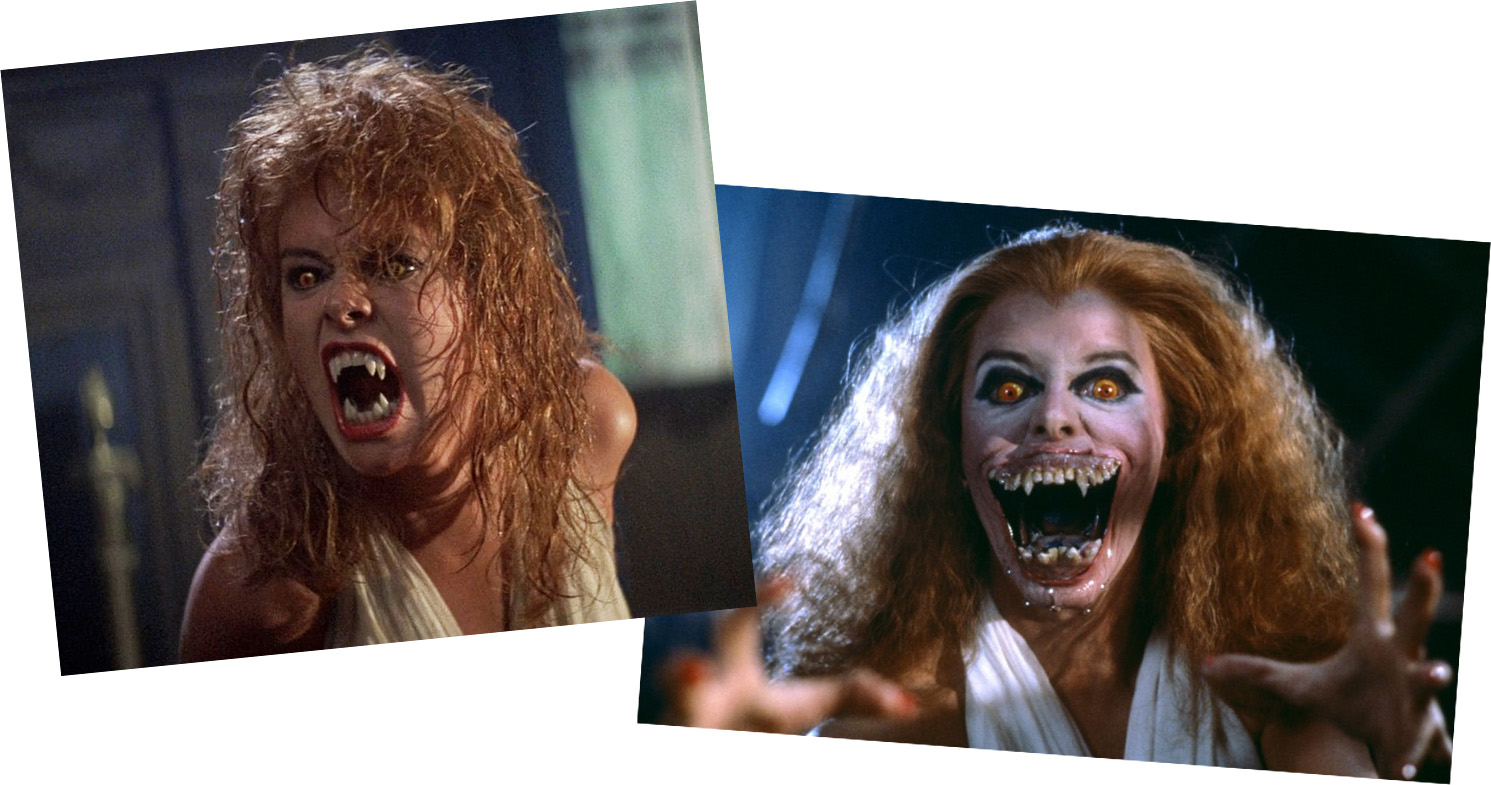
In 1986 we were treated to the zany film Vamp staring Grace Jones as Katrina, the Vampire head matron at a strip club. You can see a direct correlation between Fright Night and Vamp as far as the make-up effects on the vampires goes (incorporating more fangs, and really just “going for it”), and in turn with the plot of this film you can see that it had an influence on From Dusk Till Dawn. In fact, it’d be fair to say that From Dusk Till Dawn is a mash-up of Reservoir Dogs and Vamp. For the life of me I couldn’t pin down exactly who worked on the vampire make-up on the Vamp IMDB page, there are at least 10 effects artists listed and no companies. But if I had to guess, it would be the Chesney brothers(?), Tom, Chris and Peter. Tom and Peter in particular are credited with effects work in other flicks like A Nightmare on Elm Street 3 & 4, Pet Semetary, The People Under the Stairs, and Vampire in Brooklyn (spoiler, another film on this list), so it seems in-line with doing the vampire effects work.

The next flick with some seriously monstrous vampires would be Joel Schumacher’s The Lost Boys released in 1987. There’s definitely something to be said about The Lost Boy’s influence on From Dusk Till Dawn, if for nothing else than the film’s snappy dialogue and characters that are so damn cool it can give you a migraine. It doesn’t hurt that there’s a bit of a bait and switch in The Lost Boys where you really don’t get a full on vampire vibe to the film until you’re almost half-way in. It’s not as abrupt as From Dusk Till Dawn, but it’s there none the less. There’s also a level of brutality in the Lost Boys that is a direct connection to FDTD. This was the first film where I basically saw a vampire bite directly into a dude’s head in the same way that a frat boy pounds a beer. The effects work was overseen and designed by Greg Cannom and his Cannom Effects Group.
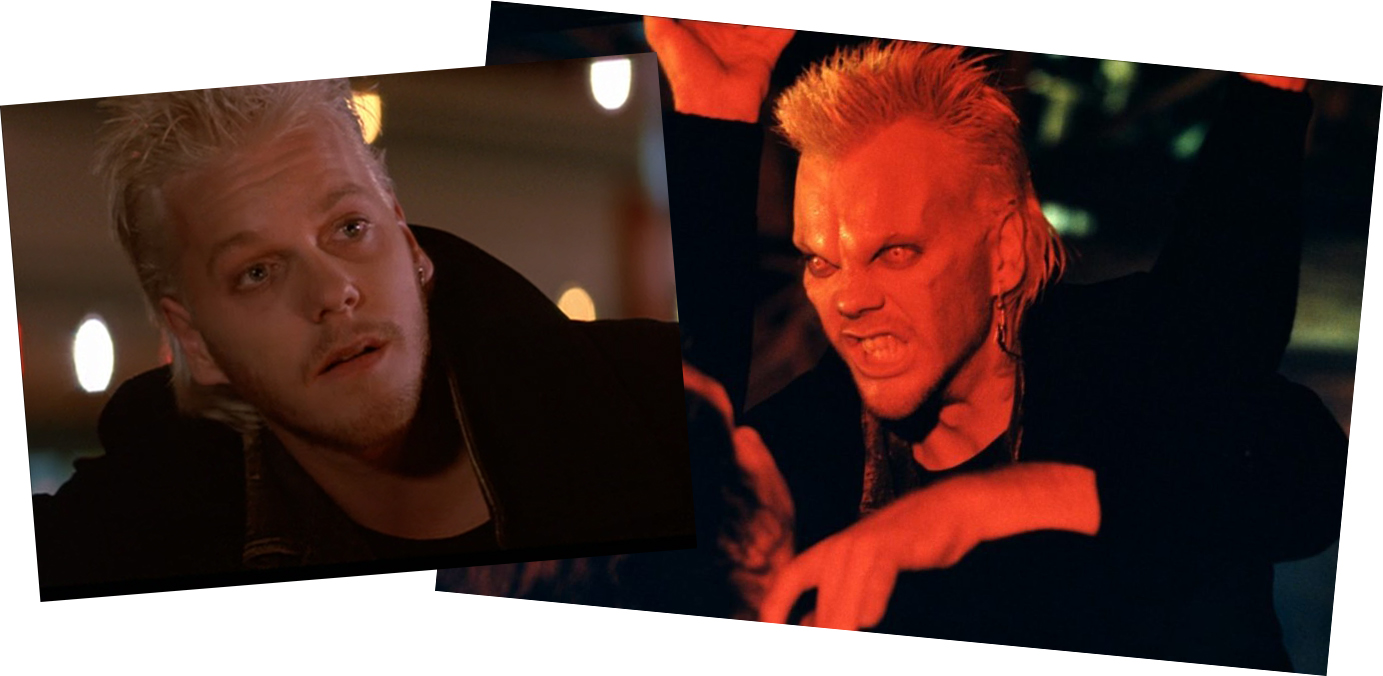
I think there’s a case to be made for the idea that Tarantino, Rodriguez and the guys at KNB Effects really wanted to take their influences on From Dusk Till Dawn on all of the 80s era vampire films, as we can see that Amanda Donohoe’s Lady Sylvia Marsh from Ken Russel’s Lair of the White Worm (released in 1988) is a very important building block for Santanico Pandemonium’s design in FDTD. While she might be a bit more crazy snake woman than vampire in appearance, she does make sacrifices to ensure her immortality, as well as being able to pass on her affliction through a bite, so we’re considering her a vampire. She probably wins for longest fangs as well. Like Vamp, I’m not 100% positive on who designed this vampire, but I’m going with my gut that says it was Simon Sayce the Special Effects Make-Up Supervisor on the film.

In 1990’s Def by Temptation, the vampire takes the form of a succubus in Cynthia Bond’s Temptress. The make up in this movie is very low budget, but Christina Bone & Rob Benevides’ prosthetics and make-up design, along with Ron Macks production design make the Temptress pretty freaky. Some of the sequences are particularly Bava-esque with their use of color. Oh, and one of the sequences makes the Temptress seem like a cross between a vampire and a Red Lectroid from Buckaroo Banzai. And that’s not a bad thing…

Next is the first in another very low budget film, the first in a franchise, Full Moon’s Subspecies which hit video in 1991. Anders Hove’s Radu Vladislas is another example of a Nosferatu-like vampire that only has one main visage, the twisted, pale monster with a set of extremely long fingers (and fingernails.) As the film series goes on Radu’s visage becomes increasingly monstrous, wrinkled and ghastly.

With Francis Ford Coppola’s version of Bram Stoker’s Dracula in 1992 we again get a vampire that is all over the map in terms of tone and appearance. This version is a mighty shapeshifter, one who shifts at times it seems by will, and at others it seems like the process requires a full molting over months. Gary Oldman’s portrayal of the Count is fascinating and the best moments in the film involve him (or Tom Waits.) I love his dapper woo-ing form, the young-looking incarnation meant to tempt Winona Ryder’s Mina away from Jonathan Harker (played by Keanu Reeves), as he seems like a partial nod to Lon Chaney’s ghoul in London After Midnight. But the sheer audacity of the old heart-sick Dracula is also amazing. The heart-shaped hairdo to the seriously hairy palms (what have you been doing in your alone time Drac?) But it’s the sequences where he takes the form of a man-bat or werewolf that I truly fall for this rendition. Now, I know I’m looking into this a bit much, but in the sequence at the end of the film when the hunters have caught Dracula and are dispatching him, the texture of the Count’s nose is very interesting, at least through the lens of this possibly influencing From Dusk Till Dawn’s designs, many of which make use of that design in the schnoz area.
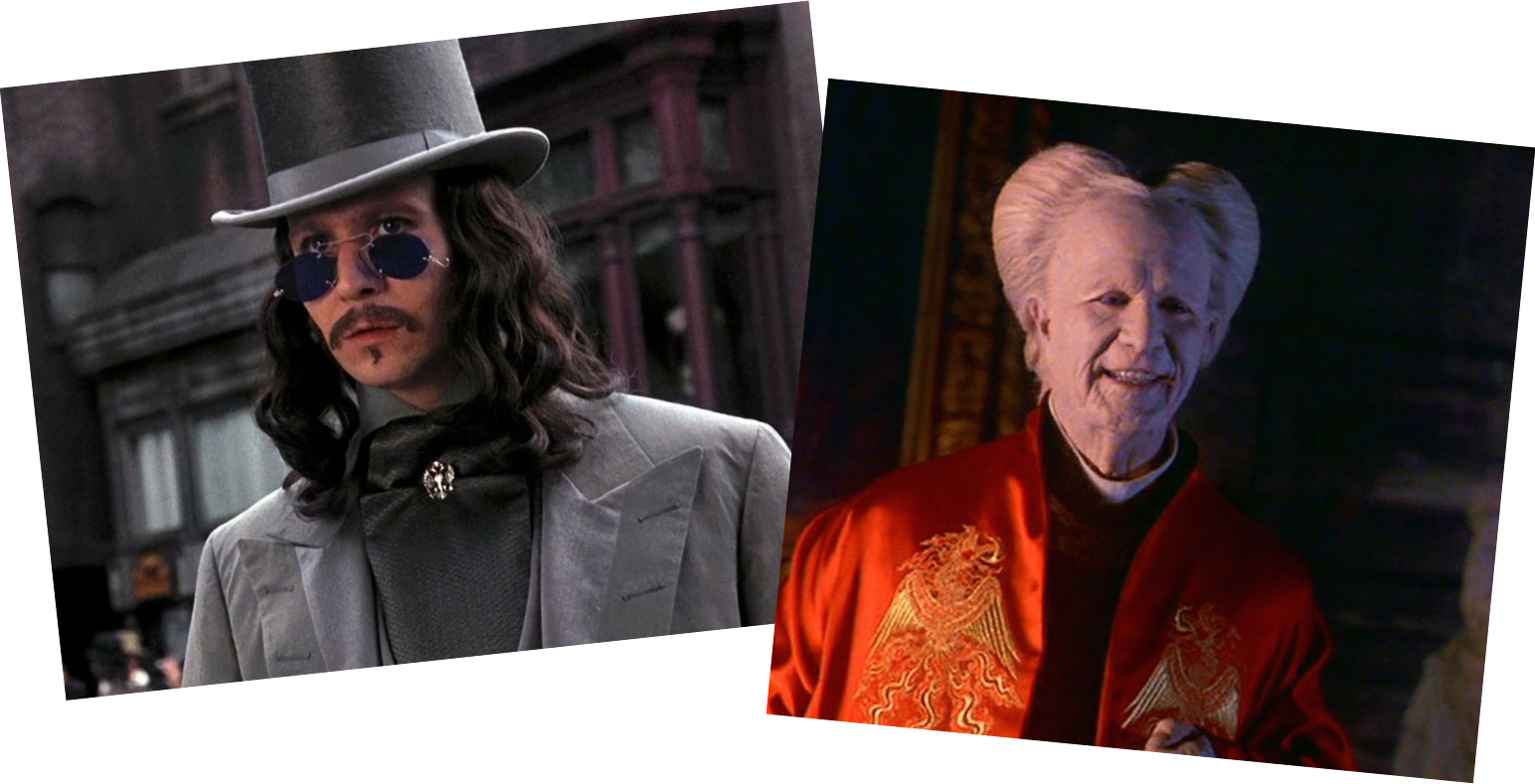

This brings us to the year before From Dusk Till Dawn was released when there was no less than four vampire movies released including two that featured more normal-looking vamps (Embrace of the Vampire and The Addiction) and two with some more in-your-face designs including Eddie Murphy’s first foray into horror, Vampire in Brooklyn, and the quirky Canadian flick Blood and Donuts.

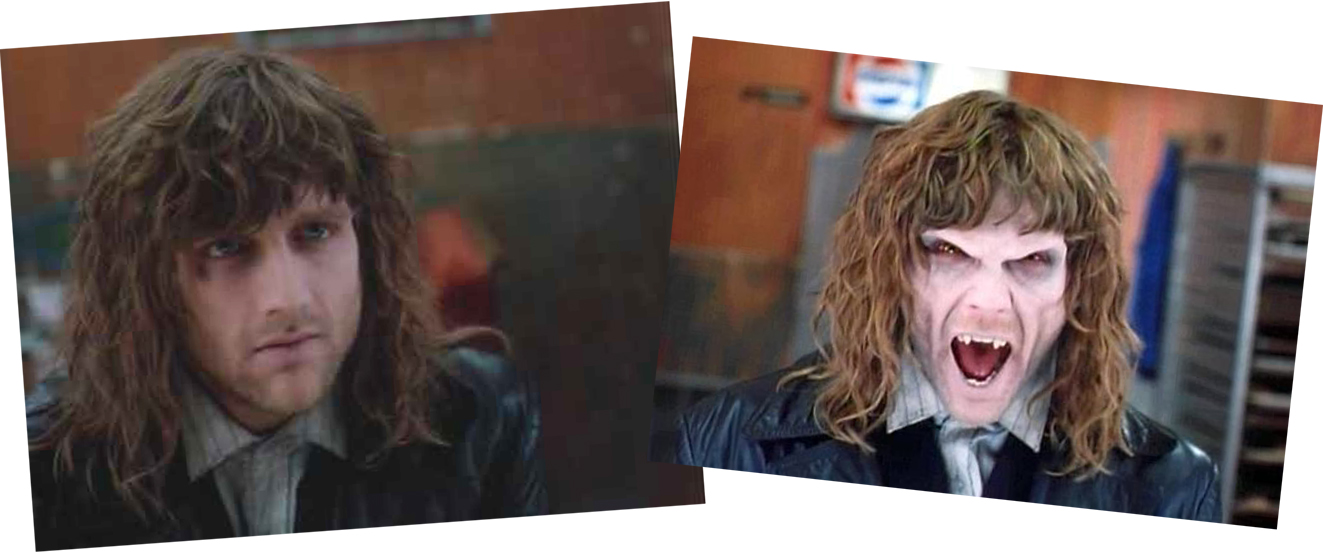
So, up until From Dusk Till Dawn hit in 1996, there were actually quite a few flicks that featured some beastly vampires. We came up with 18 of them, but we’re sure there are more. What gnarly-looking vampire movies did we miss?
